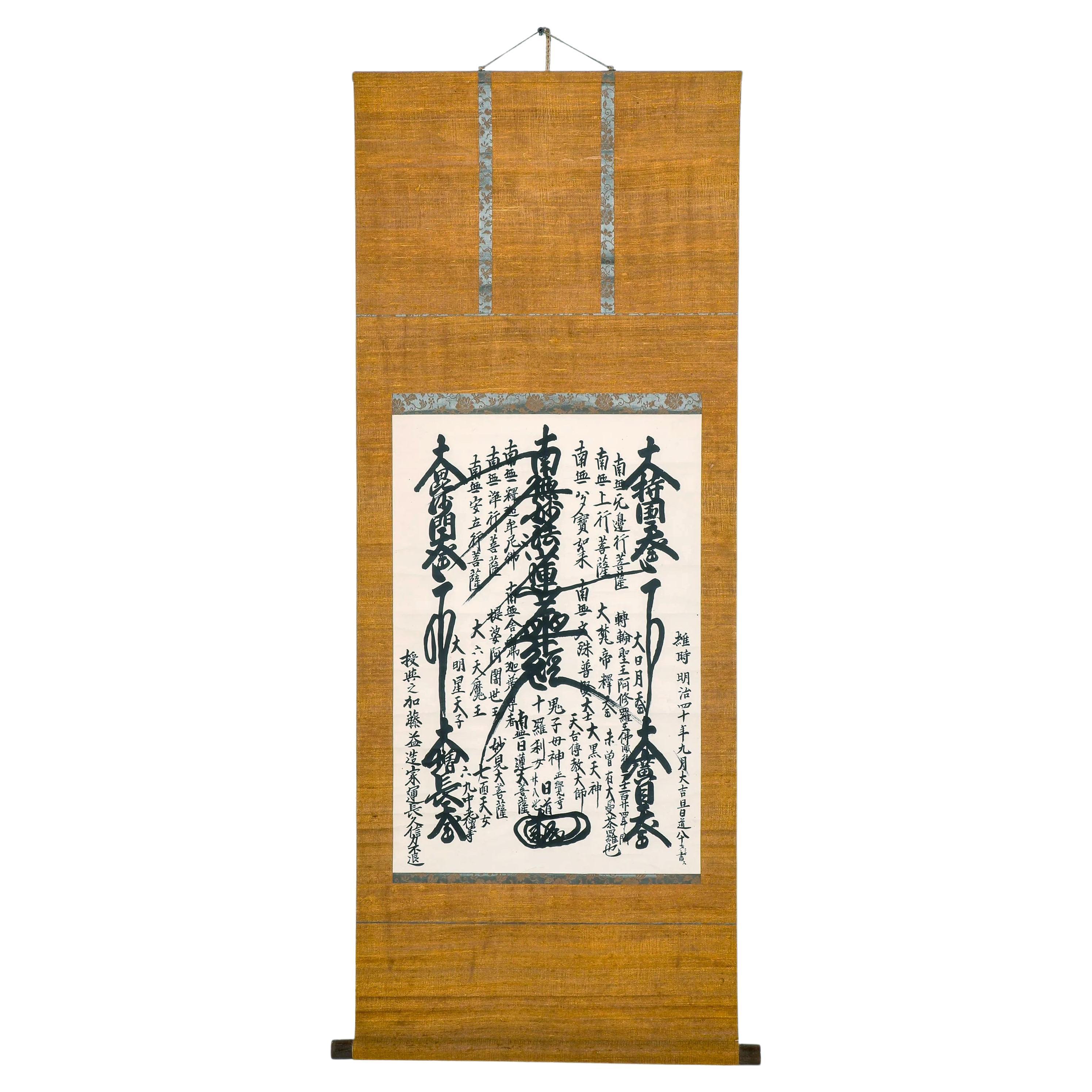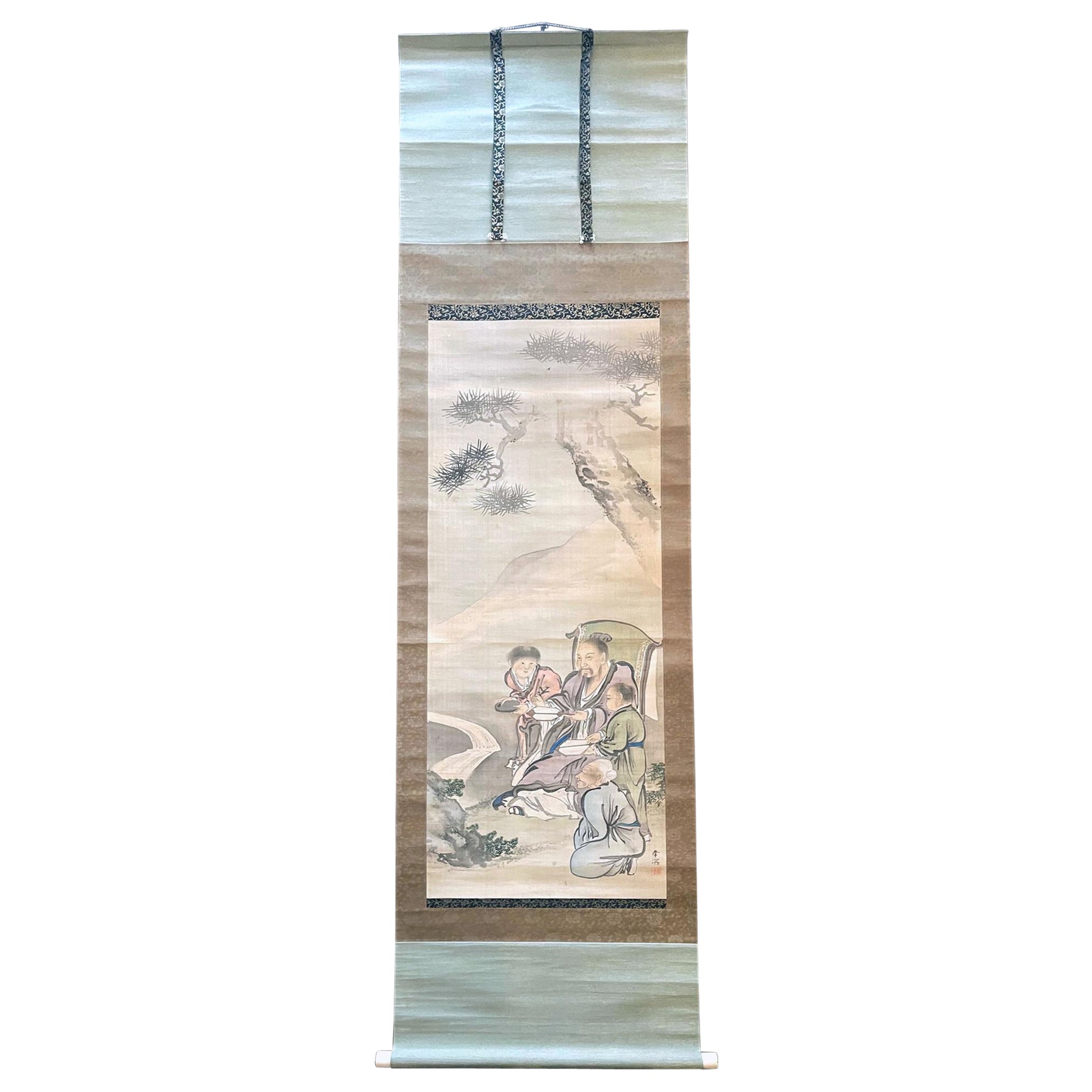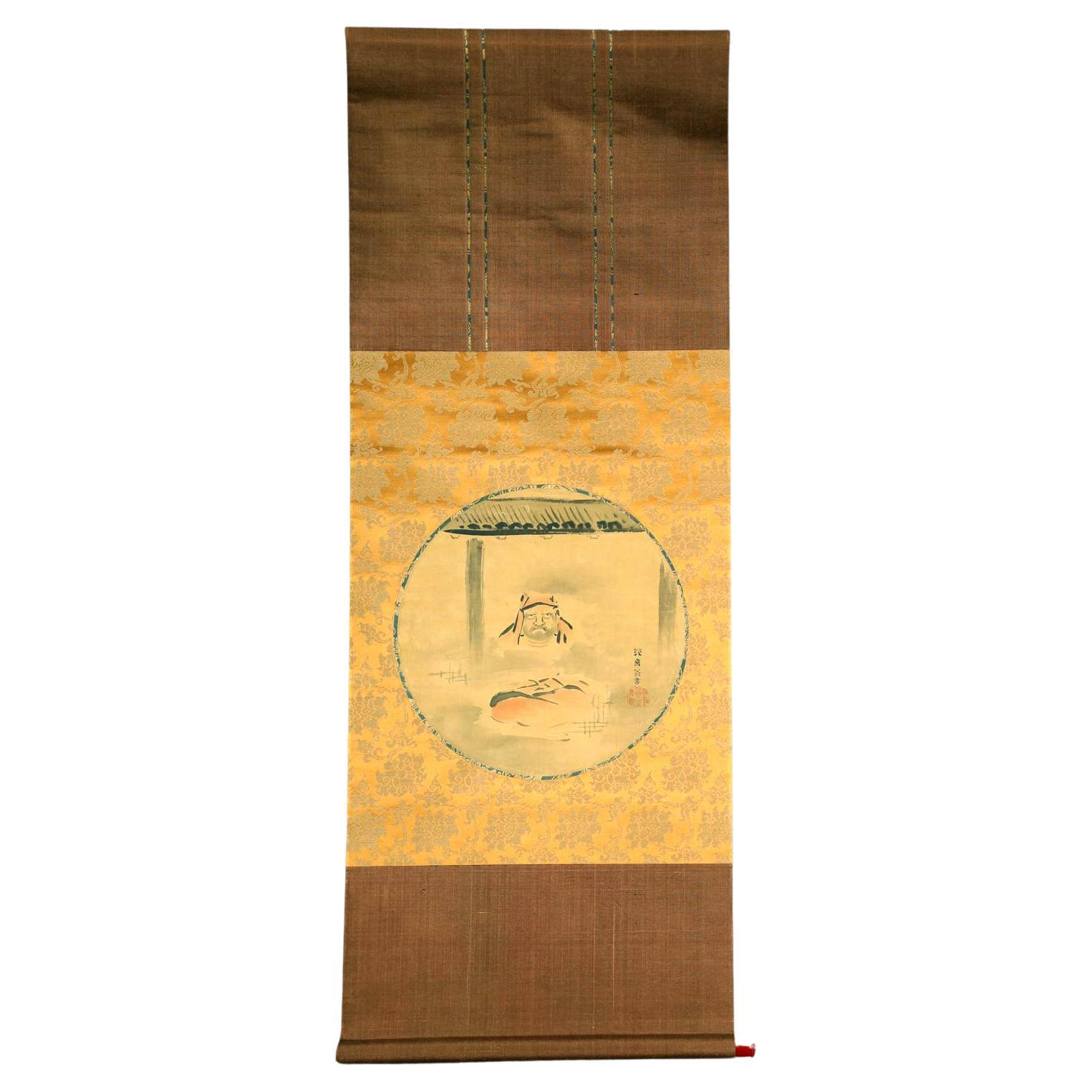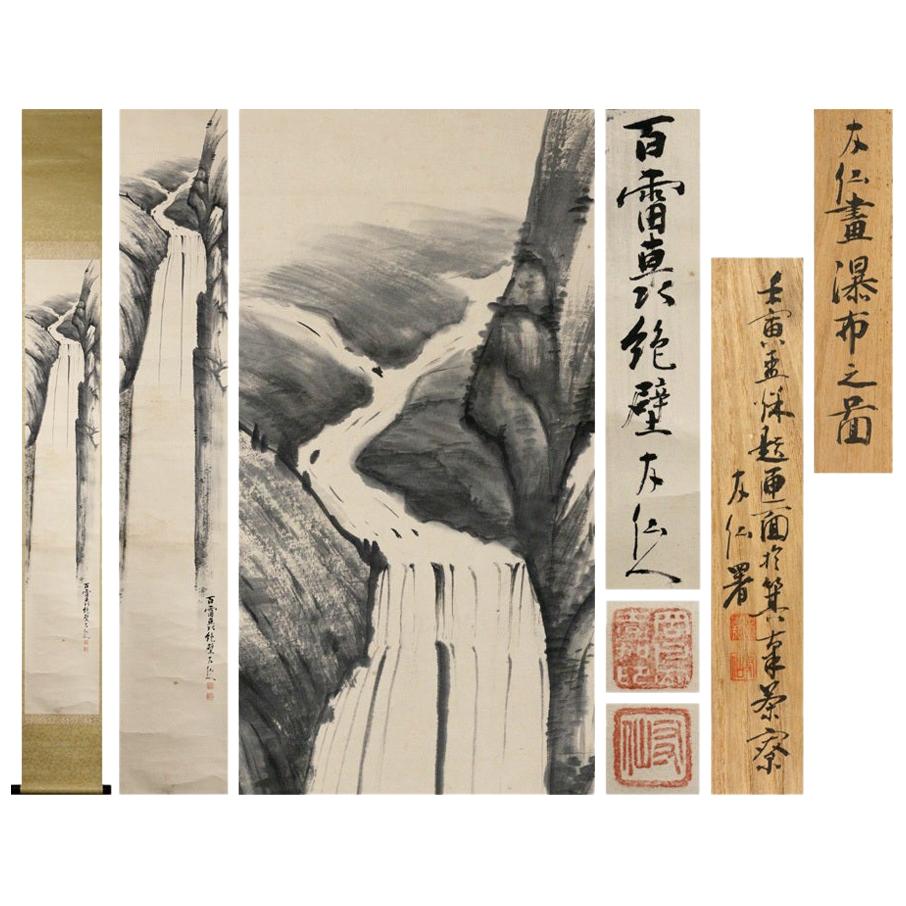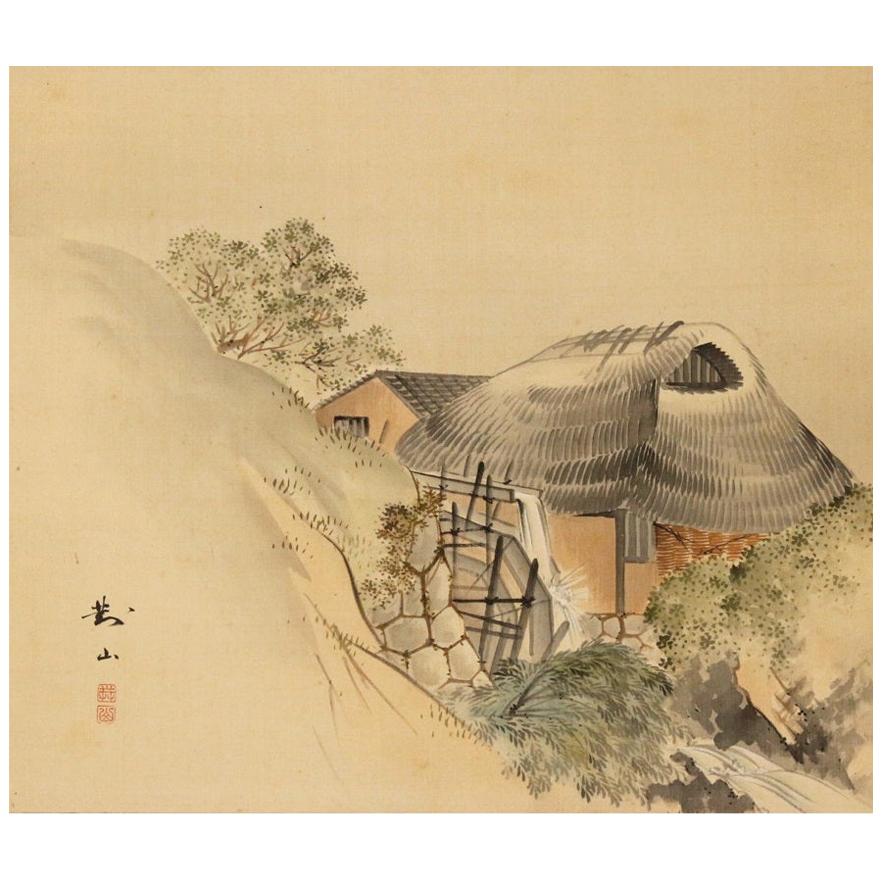Items Similar to Early Japanese Gohonzon Buddhist Calligraphy Mandala Scroll Edo Period
Want more images or videos?
Request additional images or videos from the seller
1 of 18
Early Japanese Gohonzon Buddhist Calligraphy Mandala Scroll Edo Period
About the Item
A Japanese sumi ink calligraphy Buddhist mandala mounted as a paper hanging scroll known as Kakejiku or sometimes Moji mandala. Termed as gohonzon in Japanese, it is a venerated object within Nichiren Buddhism (Hokkeshu; lotus sect). The originally concept was developed by the 13th century Buddhist priest Nichiren to guide the energy of the devotional chanting to the correct direction. The hanging scroll has a prototype design and features stylized Kanji writing of the Buddhist mantra with overflowing and interlacing fashion. It was often made for a specific person and sometimes on a specific occasion (known as Joju gohonzon) for the prays to be answered. Traditionally, the scroll is hanging as part of the accouterment of the shrine installation.
The gohonzon on offer is a fine example of an early Jujo scroll with dedication inscription on the left and date on the right, forming part of the elaborate graphic composition. It was dated to Bunka 7th year (1810) of Edo period. The paper was mounted on lining paper and bordered with two stripes of golden brocade. A yellow dyed washi paper was used as inner border before it was finally laid on a blue dyed washi paper, forming a visually striking color contrast. Historically, the original paper gohonzon of that age may have been remounted many times when it was deemed necessary.
When fully opened, the scroll measures 11" w x 46" h x 0.75"d. The size of the original ink mandala is 6.5" w. x 14.5" h. It is also inscribed and dated on the back of the scroll.
- Dimensions:Height: 1.2 in (3.05 cm)Width: 13 in (33.02 cm)Depth: 1.2 in (3.05 cm)
- Style:Edo (Of the Period)
- Materials and Techniques:
- Place of Origin:
- Period:
- Date of Manufacture:1810
- Condition:Wear consistent with age and use. Minor losses. Antique mounted as shown, with age expected wear. Small losses of the original paper on the lower edge and corner and thinning on the upper corner but mounted on and protected by the lining paper. Some discoloration on the back.
- Seller Location:Atlanta, GA
- Reference Number:1stDibs: LU945034251862
About the Seller
5.0
Platinum Seller
These expertly vetted sellers are 1stDibs' most experienced sellers and are rated highest by our customers.
Established in 2006
1stDibs seller since 2010
478 sales on 1stDibs
Typical response time: <1 hour
- ShippingRetrieving quote...Ships From: Atlanta, GA
- Return PolicyA return for this item may be initiated within 2 days of delivery.
More From This SellerView All
- Japanese Gohonzon Buddhist Calligraphy Mandala Scroll Meiji PeriodLocated in Atlanta, GAA Japanese sumi ink calligraphy Buddhist mandala mounted as a paper hanging scroll known as Kakejiku or sometimes Moji mandala. Termed as gohonzon in Japanese, it is a venerated object within Nichiren Buddhism (Hokkeshu; lotus sect). The originally concept was developed by the 13th century Buddhist priest Nichiren to guide the energy of the devotional chanting to...Category
Antique 1890s Japanese Meiji Paintings and Screens
MaterialsPaper
- Japanese Gohonzon Buddhist Calligraphy Mandala Scroll Meiji PeriodLocated in Atlanta, GAA Japanese sumi ink calligraphy Buddhist mandala mounted as a paper hanging scroll known as Kakejiku or sometimes Moji mandala. Termed as gohonzon in Japanese, it is a venerated object within Nichiren Buddhism (Hokkeshu; lotus sect). The originally concept was developed by the 13th century Buddhist priest Nichiren to guide the energy of the devotional chanting to...Category
Antique Early 1900s Japanese Meiji Paintings and Screens
MaterialsPaper
- Japanese Silk Scroll by Haruki Nanmei Edo PeriodLocated in Atlanta, GAA Japanese hanging silk scroll by late Edo period painter Haruki Nanmei (1795-1878). The gouache painting was in the tradition of Kano school and depicts an old scholar dressed in lo...Category
Antique 19th Century Japanese Edo Paintings and Screens
MaterialsSilk, Paper
- Japanese Silk Scroll of Daruma Hanabusa Itcho Edo PeriodLocated in Atlanta, GAA Japanese hanging scroll attributed to Edo period painter Hanabusa Itcho (1652-1724). The artwork features a silk roundel nicely mounted in golden brocade background. The painting depicts a robed Daruma seated in meditation with his eyes widely open. The rendition of the famous monk, one of the most beloved subjects in Japanese art, was extremely minimalistic. With just a few effective ink strokes and patches of watercolor, it managed to successfully highlight the essence and spirit of Daruma. The roundel was possibly a center fragment of a larger painting by the artist and was remounted historically. Signed with one of his artist's names. It comes with a wood scroll box with ink inscription of title and artist formal name. For a painting with the same signature, see number 1881,1210,0.1719 in the collection of the British Musuem. Also a horizontal scroll...Category
Antique 18th Century Japanese Edo Paintings and Screens
MaterialsSilk, Paper
- Antique Japanese Ink Hanging Scroll Nakabayashi Chikuto Edo PeriodBy Hidaka TetsuoLocated in Atlanta, GAAn ink painting on paper (Sumi-e) mounted with brocade borders as a hanging scroll. Entitled "Plum Blossom Under a Misty Moon", the artist was Japanese painter Nakabayashi Chikuto (1...Category
Antique 19th Century Japanese Japonisme Paintings and Screens
MaterialsBrocade, Wood, Paper
- Japanese Silk Scroll Painting of Moneys Edo Period Mori TetsuzanLocated in Atlanta, GAA Japanese mounted vertical hanging scroll painting by Mori Tetsuzan (Japanese, 1775-1841) circa 19th century Edo period. The watercolor and ink on silk ...Category
Antique 19th Century Japanese Japonisme Paintings and Screens
MaterialsSilk, Paper
You May Also Like
- Lovely Nihonga Scene Edo Period Scroll Japan Artist Yusen Okajima JapanLocated in Amsterdam, Noord HollandIt is a work drawn by Yusen Okajima known as a Japanese painter of the Shijo school as you can see. It is a waterfall map that makes you feel momentum from the top to the bottom, a...Category
Antique Early 19th Century Japanese Edo Paintings and Screens
MaterialsSilk
- Lovely Late Edo Period Scroll Paintings Japan Artist Landscape PaintedLocated in Amsterdam, Noord HollandArtist: "Hineno Taiyama" End of the Edo period painter. Osaka production. Hine Taizan (Hine Taizan, 10 years of culture (1813)-March 13, 1868 (April 24, 1869) is a literary painter...Category
Antique 19th Century Japanese Edo Paintings and Screens
MaterialsSilk
- Flower Scene Edo Period Scroll Japan 19c Artist Kiyoshi WatanabeLocated in Amsterdam, Noord HollandAs you can see, this is an old painting by Kiyoshi Watanabe, a colored iris and a red dragonfly. It has a simple yet calm texture, and the appearance of a red dragonfly standing li...Category
Antique 18th Century Japanese Edo Paintings and Screens
MaterialsSilk
- Lovely Pair Nihonga Scene Edo Period Scroll Japan Artist Matsumura Keibun JapanLocated in Amsterdam, Noord HollandEarly summer rice planting and poultry drawing drawn by Keibun Matsumura As you can see, there are two folding screens. It is an interesting work that shows the bird's figure flyin...Category
Antique Early 19th Century Japanese Edo Paintings and Screens
MaterialsSilk
- Lovely Edo Period Scroll Paintings Japan Artist Saeki Kishi Ganku Dragon CloudsLocated in Amsterdam, Noord HollandSaeki Kishi Ganku "NoboriRyuzu" silk painting hanging scroll with box Size Axis ... vertical 163.5cm horizontal 43cm picture ... vertical 96cm horizont...Category
Antique 19th Century Japanese Edo Paintings and Screens
MaterialsSilk
- Antique hanging scroll of Japanese cat/Late Edo-Meiji period/Cat paintingLocated in Sammu-shi, ChibaThis is a picture of a cat drawn by a person named "Toshizumi Nitta" from the end of the Edo period to the beginning of the Meiji period. She is a very simple and cute cat. He is a vassal of the Tokugawa Shogunate, born in Ota City, Gunma Prefecture (southern part of Gunma Prefecture). He was related to the Tokugawa family and lived in a large mansion in the Ota clan in Gunma prefecture. However, the Nitta family's territory was very small, and they were by no means a wealthy vassal. He seems to have lived quite poorly. So he painted cats and sold them to people. The Nitta family continued to draw pictures of this cat for four generations. "Nitta toshizumi" is equivalent to the fourth generation. During the Edo period, sericulture was thriving in the Kanto region. Cats were said to be the gods of silkworms, as they drive away mice, the natural enemies of silkworms. It was the Nitta family who drew such a cat on paper, pasted it in the silkworm chamber, and sold it as a mouse repellent. There were also other monks who painted pictures of cats, but the Nitta family in particular was related to the Tokugawa family, so people believed that paintings of cats had special powers. , a lot of paintings...Category
Antique Late 19th Century Japanese Edo Paintings
MaterialsPaper
Recently Viewed
View AllMore Ways To Browse
Kano Chikanobu
Kano Tanyu
Meiji Period Japanese 6 Panel Screen
Antique Edo Period Kano Screen
Asian Lacquer 6 Panel Folding Room Screen
Thai Rubbing
6 Panel Showa Screen
Antique 2 Panel Japanese Screens
Kishi Ganku
Tani Buncho
Antique Silk Screens 6 Panels
Chinese 6 Panel Coromandel Screen
Coromandel Chinese Lacquer Screen 4 Panel
Kawai Gyokudo
Kishi Renzan
Wood Coromandel 6 Fold
18th Century 4 Fold Screen Chinese
4 Panel Japanese Screen Kyoto

